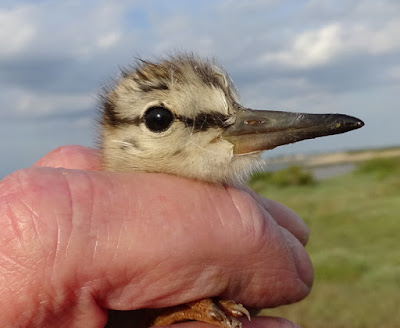Also one corn bunting was singing too, possibly a second songster too, one female nest-building close to the seawall. Three reed buntings, three reed warblers were along the dyke or nearby.
A female cuckoo "bubbled" over the farmyard while a hepatic phase bird was seen again by the dyke and a dozen house martins were over the buildings.
A common buzzard was over Reeveshall, a Mediterranean gull flew over, a greylag goose family had at least two goslings, while grey heron and little egret flew out of the dyke and ditch.
In the Pyefleet two common terns, two great crested grebes, 30+ shelduck and 30+ redshank were seen as the tide came in. Other than a few oystercatchers no other waders were seen.
A common buzzard hung in the wind over the west end of Langenhoe ranges and a couple of kestrels were the only other raptors seen.
Although there was a strong breeze blowing over Maydays, several butterflies enjoyed the lee of the seawall such as this small tortoiseshell. Two painted ladies flew off rapidly after they were flushed from the long grass. Also noted were Essex skipper, common blue, 25 meadow browns, 8 small heaths and a small white.
Also enjoying the periods of sunshine were emperor dragonfly, black-tailed skimmer and four-spotted chaser.
Most of the butterflies at Maydays farm were enjoying this sheltered side of the seawall with lots of flowering narrow-leaved birds foot trefoil.
Flushed from the long grass was this neatly marked Mother Shipton moth, with its markings of an old lady's face on the wings.
On Saturday 20th the cuckoo was calling from the park in the morning and a painted lady was seen there too. The swallow is still nesting inside the bird hide.
On Friday 19th a young sedge warbler chick newly fledged was foraging on the seawall with its parent close-by. Further along the seawall another sedge warbler was heard singing from the top of a bush. Three oystercatchers were still in the middle of the fallow field and a cuckoo was heard singing from Ray Island. Over the fields and houses 25 swifts were seen flying about.
A red kite flew over Martin Cock's West Mersea garden on Thursday 18th in the morning. A walk by Martin at Maydays on Tuesday 16th provided another sighting of two hobbies flying over Langenhoe.
A bit of exotic colour near Hall Barn in West Mersea on Friday 19th was provided by a free-flying lovebird, that perched up in a birch tree and squawked happily away. Not sure which species but a light reddish face and green body showed up well. Sadly no sign of its companion!
The moth trap is producing a few more moths now that the nights are warming up a bit. Ninety moths of 18 species of macro moth were noted in the trap in Firs Chase by 5.30am on the 20th. This included this orange footman pictured above, a moth that has become more widespread in recent years here.
Two elephant hawk-moths were the most notable, while two thirds of the catch were lots of heart and darts. Also noted were marbled minor, heart and club, figure of eighty, flame shoulder, bright-line brown-eye, lime-speck pug, green pug, dark arches, spruce carpet, clouded silver, willow beauty, riband wave, barred yellow, and common marbled carpet.








































